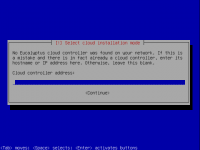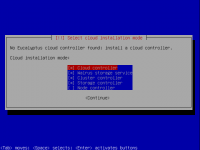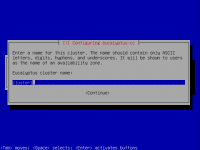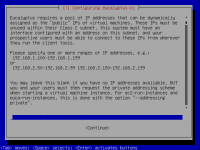Difference between revisions of "Ubuntu Enterprise Cloud"
Onnowpurbo (talk | contribs) |
Onnowpurbo (talk | contribs) |
||
| Line 154: | Line 154: | ||
# Verify Registration. | # Verify Registration. | ||
| − | Steps a to e should only be required if you're using the UEC/PackageInstall method. Otherwise, if you are following the UEC/CDInstall method, these steps should already be completed automatically for you, and therefore you can skip a to e. | + | Steps a to e should only be required if you're using the UEC/PackageInstall method. Otherwise, if you are following the UEC/CDInstall method, these steps should already be completed automatically for you, and therefore you can skip a to e. |
| + | ===Exchange Public SSH Keys=== | ||
| + | The Cloud Controller's eucalyptus user needs to have SSH access to the Walrus Controller, Cluster Controller, and Storage Controller as the eucalyptus user. | ||
| + | Install the Cloud Controller's eucalyptus user's public ssh key by: | ||
| + | * On the target controller, temporarily set a password for the eucalyptus user: | ||
| + | |||
| + | sudo passwd eucalyptus | ||
| + | |||
| + | * Then, on the Cloud Controller: | ||
| + | |||
| + | sudo -u eucalyptus ssh-copy-id -i /var/lib/eucalyptus/.ssh/id_rsa.pub eucalyptus@<IP_OF_NODE> | ||
| + | |||
| + | * You can now remove the password of the eucalyptus account on the target controller, if you wish: | ||
| + | |||
| + | sudo passwd -d eucalyptus | ||
| + | |||
| + | |||
| + | |||
| + | ==Configure the Services== | ||
| + | |||
| + | On the Cloud Controller: | ||
| + | |||
| + | * For the Cluster Controller Registration: | ||
| + | ** Define the shell variable CC_NAME in /etc/eucalyptus/eucalyptus-cc.conf | ||
| + | ** Define the shell variable CC_IP_ADDR in /etc/eucalyptus/eucalyptus-ipaddr.conf, as a space separated list of one or more IP addresses. | ||
| + | |||
| + | * For the Walrus Controller Registration: | ||
| + | ** Define the shell variable WALRUS_IP_ADDR in /etc/eucalyptus/eucalyptus-ipaddr.conf, as a single IP address. | ||
| + | |||
| + | On the Cluster Controller: | ||
| + | |||
| + | * For Storage Controller Registration: | ||
| + | ** Define the cluster name in the shell variable CC_NAME in /etc/eucalyptus/eucalyptus-cc.conf | ||
| + | ** Define the shell variable SC_IP_ADDR in /etc/eucalyptus/eucalyptus-ipaddr.conf, as a space separated list of one or more IP addresses. | ||
==Referensi== | ==Referensi== | ||
Revision as of 17:08, 1 October 2010
Objective
From this Tutorial you will learn how to install, configure, register and perform several operations on a basic UEC setup that results in a cloud with a one controller "front-end" and one or several node(s) for running Virtual Machine (VM) instances. You will also use examples to help get you started using your own private compute cloud.
Download
- Download iso Ubuntu Server dari
http://www.ubuntu.com/server/get-ubuntu/download
STEP 1: Prerequisites
To deploy a minimal cloud infrastructure, you’ll need at least two dedicated systems:
- a front end
- one or more node(s)
The following are recommendations, rather than fixed requirements. However, our experience in developing this documentation indicated the following suggestions.
Front End
Use the following table for a system that will run one or more of:
- the cloud controller (clc)
- the cluster controller (cc)
- walrus (the S3-like storage service)
- the storage controller (sc)
| Hardware | Minimum | Suggested | Notes |
|---|---|---|---|
| CPU | 1GHz | 2 x 2GHz | for an all-in-one front end, it helps to have at least a dual core processor |
| Memory | 2GB | 4GB | the Java web front end benefits from lots of available memory |
| Disk | 5400rpm IDE | 7200rpm SATA | slower disks will work, but will yield much longer instance startup times |
| Disk Space | 40GB | 200GB | 40GB is only enough space for only a single image, cache, etc., Eucalyptus does not like to run out of disk space |
| Networking | 100Mbps | 1000Mbps | machine images are hundreds of MB, and need to be copied over the network to nodes |
Node(s)
The other system(s) are nodes, which will run:
- the node controller (nc)
These systems will actually run the instances. You will need one or more systems with:
| Hardware | Minimum | Suggested | Notes |
|---|---|---|---|
| CPU | VT extensions | VT, 64-bit, Multicore | 64-bit can run both i386, and amd64 instances; by default, Eucalyptus will only run 1 VM per CPU core on a Node |
| Memory | 1GB | 4GB | additional memory means more, and larger guests |
| Disk | 5400rpm IDE | 7200rpm SATA or SCSI | Eucalyptus nodes are disk-intensive; I/O wait will likely be the performance bottleneck |
| Disk Space | 40GB | 100GB | images will be cached locally, Eucalyptus does not like to run out of disk space |
| Networking | 100Mbps | 1000Mbps | machine images are hundreds of MB, and need to be copied over the network to nodes |
STEP 2: Install the Cloud/Cluster/Storage/Walrus Front End Server
- Download the 10.04 Server ISO
- When you boot, select “Install Ubuntu Enterprise Cloud”.
- The installer will detect if any other Eucalyptus components are present.
- You can then choose which components to install, based on your chosen topology.
- It will ask two other cloud-specific questions during the course of the install:
- Name of your cluster, e.g. cluster1.
- A range of public IP addresses on the LAN that the cloud can allocate to instances, e.g. 192.168.1.200-192.168.1.249.
STEP 3: Install the Node Controller(s)
The node controller install is even simpler. Just make sure that you are connected to the network on which the cloud/cluster controller is already running.
- Boot from the same ISO on the node(s)
- Select “Install Ubuntu Enterprise Cloud”
- It should detect the Cluster and preselect “Node” install for you
- Confirm the partitioning scheme
- The rest of the installation should proceed uninterrupted; complete the installation and reboot the node
STEP 4: Register the Node(s)
As of Ubuntu 10.04 LTS, all component registration should be automatic, assuming:
- Public SSH keys have been exchanged properly
- The services are configured properly
- The services are publishing their existence
- The appropriate uec-component-listener is running
- Verify Registration.
Steps a to e should only be required if you're using the UEC/PackageInstall method. Otherwise, if you are following the UEC/CDInstall method, these steps should already be completed automatically for you, and therefore you can skip a to e.
Exchange Public SSH Keys
The Cloud Controller's eucalyptus user needs to have SSH access to the Walrus Controller, Cluster Controller, and Storage Controller as the eucalyptus user.
Install the Cloud Controller's eucalyptus user's public ssh key by:
- On the target controller, temporarily set a password for the eucalyptus user:
sudo passwd eucalyptus
- Then, on the Cloud Controller:
sudo -u eucalyptus ssh-copy-id -i /var/lib/eucalyptus/.ssh/id_rsa.pub eucalyptus@<IP_OF_NODE>
- You can now remove the password of the eucalyptus account on the target controller, if you wish:
sudo passwd -d eucalyptus
Configure the Services
On the Cloud Controller:
- For the Cluster Controller Registration:
- Define the shell variable CC_NAME in /etc/eucalyptus/eucalyptus-cc.conf
- Define the shell variable CC_IP_ADDR in /etc/eucalyptus/eucalyptus-ipaddr.conf, as a space separated list of one or more IP addresses.
- For the Walrus Controller Registration:
- Define the shell variable WALRUS_IP_ADDR in /etc/eucalyptus/eucalyptus-ipaddr.conf, as a single IP address.
On the Cluster Controller:
- For Storage Controller Registration:
- Define the cluster name in the shell variable CC_NAME in /etc/eucalyptus/eucalyptus-cc.conf
- Define the shell variable SC_IP_ADDR in /etc/eucalyptus/eucalyptus-ipaddr.conf, as a space separated list of one or more IP addresses.
Referensi
- http://www.ubuntu.com/cloud/private
- http://www.ubuntu.com/cloud/private/deploy
- https://help.ubuntu.com/community/UEC
- https://help.ubuntu.com/community/UEC/CDInstall




